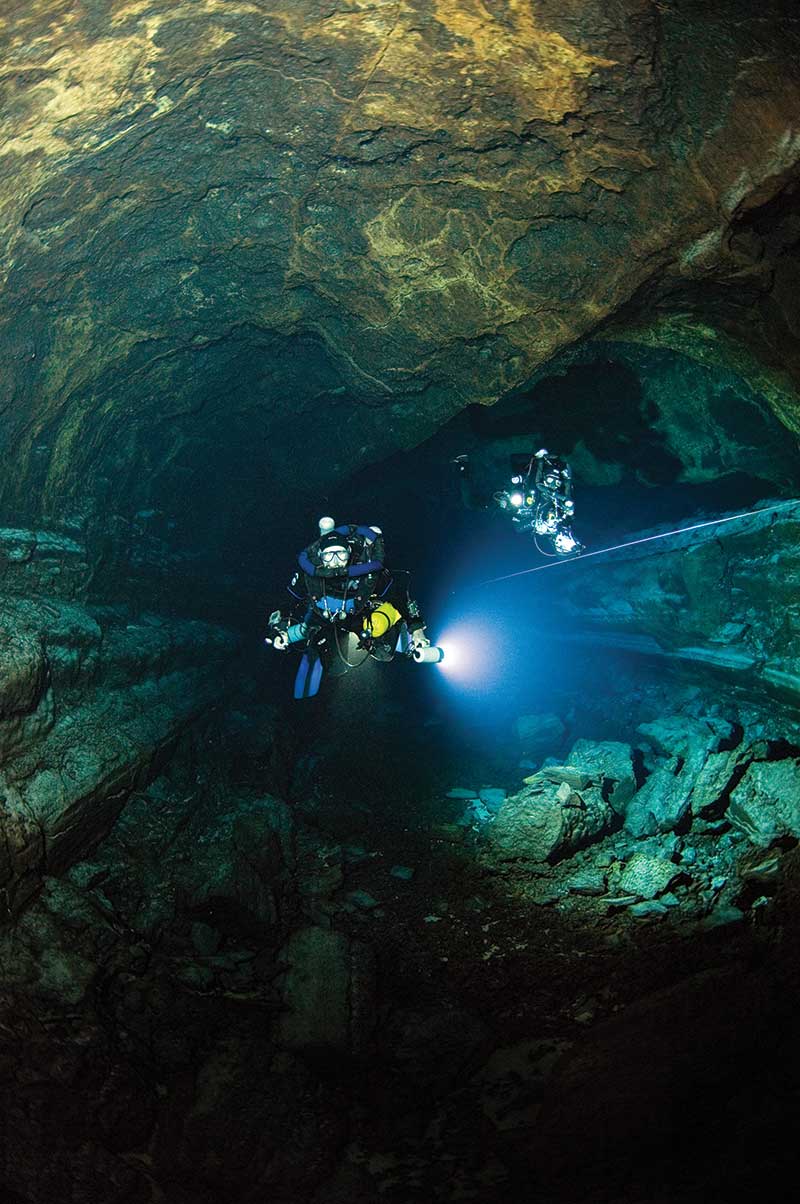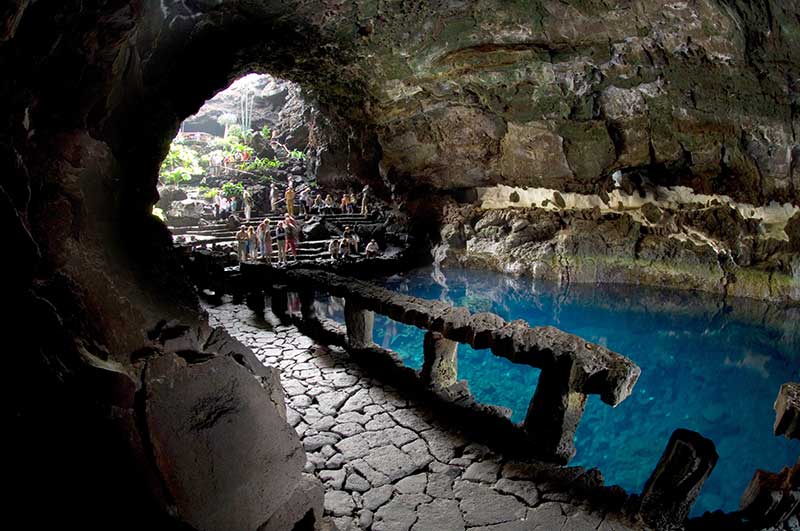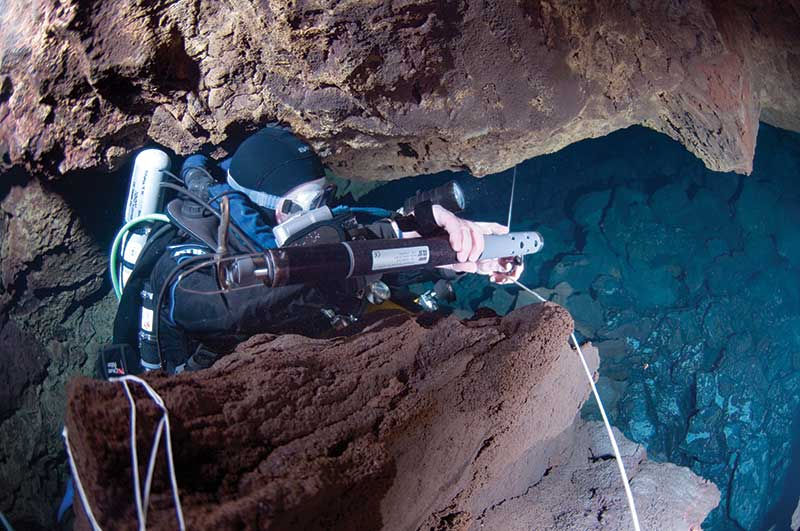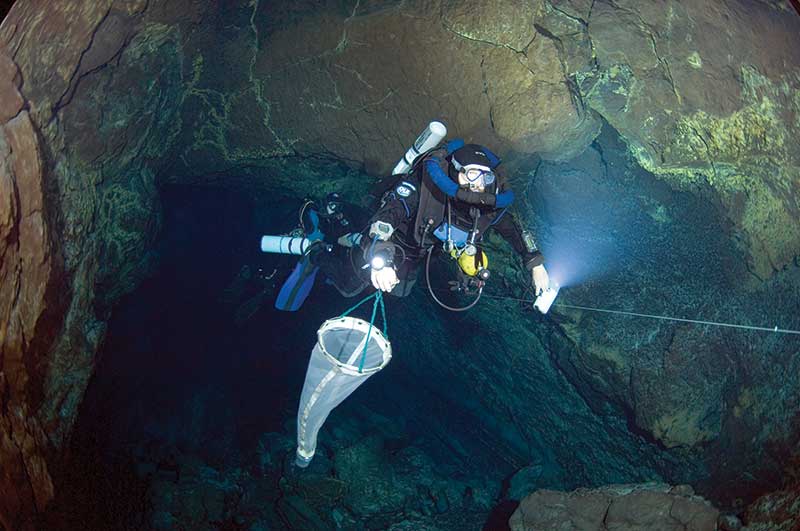The Tunnel to Atlantis
Words and Photography By Jill Heinerth

Nine-tenths of a mile (1.4km) inside a submerged lava tube in the depths of the Monte Corona Volcano, cave diving explorer Sheck Exley faced what should have been certain death. It was 1983 when he and his dive partner Ken Fulghum hoped to make a record-breaking dive exploring a cave known as the Tunnel to Atlantis. It was the longest submerged lava tube cave in the world, just 60 miles (96km) off the North African coastline on the island of Lanzarote. At a depth of 180 feet (55m), while buzzed from narcosis, they experienced one of the most catastrophic gear failures imaginable. Fulghum had already turned the dive, leaving Exley to survey their exploration work alone. In the confusion of a loud bang, Fulghum swam rapidly back towards Exley without realizing he was the source of the sound. In his biography, Caverns Measureless to Man, Exley describes the moment when Fulghum swam up to him breathing the last gasp from his tanks at their maximum penetration point, “Sometimes I wonder if I really did drown in Atlantida… At any rate, the incident certainly makes accepting the disappointments of life easier. After all, I could be floating lifeless in a volcanic blue hole on Lanzarote instead of dealing with the problems of life.”
First Fulghum was able to breathe from Exley’s long hose, but it wasn’t long before Exley’s back-mounted double tanks were nearing empty. They increased their pace to try to reach a pair of stage bottles while sharing the last of his air. “One last, labored breath, then my air was completely gone,” he wrote. Still short of the stage drop, they hurried for the tanks ahead, lungs in spasm, hungry for air. With the second depot at 1550 feet (472m) of penetration, they sprinted towards the next gas drop, but soon had to resort to buddy breathing from one tank. They ran out of air again. Dizzy from carbon dioxide build-up and narcosis, the duo somehow managed another suffocating sprint to the final tanks. Despite snagging the guideline numerous times, they kept their composure and arrived at their first decompression stop within sight of the surface. With a long compulsory decompression hang ahead, they knew they would run out of gas once more. But with the nearest recompression chamber in Madrid, Spain, they wanted to avoid getting bent. One of them would have to surface and yell for more tanks. Exley said the decision was easy. It was Fulghum’s incident, so he would be the one to break deco long enough to summon help. Fortunately for the pair, biologist/cave diver Tom Iliffe was in the cavern area awaiting their return. When Ken surfaced with a frantic call for gas, Iliffe pitched full double tank sets into the basin pool. They tumbled down the slope to Exley at nearly 70 feet (21m) of depth. By some twist of fate, everyone made it home safe that day. After the incident, the cave remained closed to divers.

New expedition, new approach
Over 35 years later, I had the fortune to journey to Atlantida Cave with Dr. Tom Iliffe to look for rare cave-adapted lifeforms inside the lava tubes. The peaceful subtropical island of Lanzarote hides its volatile past. Along this island arc are dynamic features formed from sudden violent eruptions. The cave system associated with Atlantida is quite young on a geologic time scale. The tunnels took shape a mere three to four thousand years ago during great eruptions of the Corona Volcano. A massive explosion carpeted lava down the slopes of the mountain. As the surface of the lava cooled and solidified, a thundering torrent of molten magma continued to pour through the core like a virtual subterranean fire hose of lava. When the molten rock met the ocean, a massive explosion vaporized seawater in its path as the hot tributary plunged below the surface. The final result was a tunnel four miles (6.5km) long that extends from the base of the volcano, down the side of the island to the coastline, before continuing an additional 1530 yards (1.4km) under what is now the sea floor. From its vast size, unparalleled grandeur and enduring mysteries, it is easy to see why this final submarine section of the lava tube became known as the Tunnel to Atlantis.
Not wishing to bring up ghosts of the past, Dr. Iliffe planned a completely different approach to exploring Atlantida in 2008. By using closed-circuit rebreathers, our team would be able to penetrate the cave with higher margins of safety while minimizing our effect on the environment that is home to unique stygobitic cave animals. Iliffe explained, “The first time I came to this cave, we used conventional open circuit scuba, where every time a diver exhales, all their exhaled gas is lost as bubbles. Now we are using a more modern technology. We are using computer controlled close-circuit rebreathers. This greatly lessens our impact on the cave…there are no bubbles and no polluting oxygen. We are not adding additional oxygen to an oxygen-poor environment and we are preserving the character of the ecosystem in which the animals depend.”
Several collapses on the lower slopes of the Monte Corona volcano provide entrances to the cave system—including over a mile (1.6km) of passage opened as two separate tourist destinations. We accessed many other wild portions of the terrestrial lava tubes with basic dry caving and sump diving techniques.

On with the show
Diving in Atlantida Tunnel is only possible through rare scientific permits, but it is not because of the challenges of entry. To reach the dive site, we walked down through a show cave complete with a swimming pool, restaurants, and concert hall. We paraded past tourists standing at the bar, carrying our rebreathers, emergency gear, and drysuits. We weaved a course through the cafe tables to reach a wooden railing. It was there that we climbed over the fence and scrambled down a boulder slope to get to the water.
The show cave itself attracts thousands of visitors every year. Lanzarote-born artist Cesar Manrique has magically blended the stark volcanic landscape and blue water of the cave with artistic features, including a grand stairway and an extensive museum on vulcanology. A natural auditorium space can seat 600 and is renowned for its excellent acoustics. The beautiful environment is embellished with gentle, new age music, inspiring visitors to whisper as they walk reverently through the cathedral-like spaces along a walkway beside the Jameo Chico Lagoon. In the shallow lagoon pool, what appears to be twinkling stars dot the black volcanic rock. The points of white move along slowly and are soon revealed to be blind albino crabs. They are found in this underground lake and nowhere else on earth, other than on deep ocean smoking vents.
Exotic and colorful algae that are fed by the dim mix of lights and the fluctuating tidal flows adorn the walls of the entry pool to Atlantida Tunnel. Festive bands of gold, green, and cyan algae brightly contrast stark maroon and black lava rock. Once submerged, I was struck by the sheer size of the cave passage often soaring to over 50 feet (15m) in height with gin-like water offering unequaled visibility, over 200 feet (60m).
Swimming with Tom down the passage on the first dive, I was fascinated by what appeared to be a white deposit of silt on the rocks. Finally curious enough to touch the material, I discovered that what I thought was sediment was a sort of hard submarine cement, coating the horizontal surfaces of the rock. There was almost no silt to disturb in the mostly black-walled cave.
Accustomed to diving in limestone caves formed over hundreds of thousands of years, I found that diving in a younger volcanic cave felt very different. We noted speleothems in one section of the cave. Rather than being formed one grain of calcite at a time, these dripstone formations were born from the molten rock. Scours from rapidly flowing lava etched the walls in distinct layers. In places, undulating lava layers peeled off the wall like a surfer’s wave frozen in time.
While Tom and I enjoyed our first dive into the cave, team members Jim Rozzi and Terrence Tysall worked tirelessly arranging fill logistics. Oxygen was scarce and expensive, costing us $400 for a K-bottle. Fortunately, we brought along a small booster pump that would enable us to use every bit of precious gas we bought. I was glad to be using a rebreather to keep the costs down.
While swimming through vast dark tunnels, something white in the distance began to take shape. As we closed in, I realized we were approaching a spot known as Sand Mountain, some 2300 feet (700m) inside the cave. A tiny opening in the ceiling of the cave allowed single grains of sand from the ocean floor to drop into the cave and form a monument over 50 feet (15m) high. Urchin spines, small shells, and even tiny swimming animals punctuated the slope that looked like the bottom half of an hourglass timer. We captured biological specimens from the surface and interior of the sand mound in tiny vials. The samples contained both undocumented species and new records from this unusual habitat.

Searching
But the animals we most wanted to find were those associated with a great scientific mystery. Biologists Pedro Oromi and Stefan Konemann hoped Tom would find an elusive crustacean that had been first collected here twenty-five years earlier. The rare animal called remipede is one of the oldest living fossils on the planet. Un-evolved for some hundreds of millions of years, these creatures could offer vital clues about evolution and survival of life on our planet.
I was intrigued by the fact that these ancient creatures are living in a very young cave. This cave did not even exist as a home for their ancestors. Could they have migrated from an adjacent, but much older location? Although we could not answer questions about where these animals came from, we know that closely related remipedes from the same genus inhabit caves on the opposite side of the Atlantic. Their origin story may have arisen from the breakup of the continents in the ancient Tethys Sea. Remipedes are found in caves in the Bahamas, the Yucatan, Cuba, the Dominican Republic, and even remote parts of Western Australia. It was a real highlight of our project to collect several remipede specimens that appear to represent an entirely undocumented species.
Despite the success of the expedition’s efforts to collect keystone animals, many questions remain. Where do these darkness-loving animals originate? Do they live in deep ocean habitats or tiny spaces within the matrix of mid-ocean ridges and seamounts? Did they ride around the globe on ancient drifting continental rafts? Is the apparent rarity an indication of changing water conditions or a testament to perfection in evolutionary form?

Survival strategy
Stygobitic cave animals have a unique survival strategy. These creatures of the sub-aquatic darkness develop improved senses of smell, taste, and vibration detection. Eyes and pigment, and other unused anatomical features, gradually disappear. These animals are often endemic to a single, remote site, adapting to its particular environment and very scarce food sources.
Dr. Iliffe summed it up best, “Many of these animals are basically missing links in helping us to understand the origins of life in the oceans and generally the origins of life on Earth. They are new forms of life, never found anywhere else on the planet. The animals here provide us with a glimpse of what the Earth was like many, many millions of years ago.”
Unlike divers, these adaptable creatures somehow thrive in low levels of oxygen. And unlike most people encountering a potentially fatal reality, Sheck Exley and Ken Fulghum adapted to their situation, retaining composure during one of the most spectacular emergency exits in cave diving history.
In case you’ve been hiding under a rock (or in a volcano), listen to Jill’s podcast: www.intotheplanet.libsyn.com
Leave a Comment







